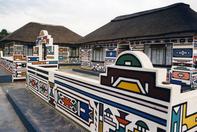Materials Used to Build Rural Homesteads
Many rural communities in South Africa continue to build their homesteads from mud bricks and readily available materials like wood, stone and thatching grass.

Where possible, these materials are supplemented with corrugated iron sheeting and steel frame windows, but items of this kind are not always easy to obtain in outlying areas. In many cases, commercially manufactured materials are either too expensive or too difficult to transport on the often badly maintained roads servicing relatively inaccessible villages.
Rural communities devote much time to maintaining their homes, which are highly susceptible to damage by heavy rains and various insects, notably termites. The latter threat can be obviated by using stone and the wood of the tamboti tree (Spirostachys africana), known to repel insects, but not all communities have access to these durable indigenous materials.
The Creativity of Female Muralists
In many rural areas men still commonly leave home to work in the cities, returning only at Christmas and Easter. It is therefore mainly women who bear the burden of responsibility for looking after rural homesteads. In some places, these women continue to decorate their homes with bold geometric designs using either clay or commercially available paints.
Alternatively, they etch delicate patterns into the wet surface of newly plastered walls. Generally speaking these motifs are based on traditional designs, like those associated with certain beadwork styles. But these comparatively old patterns are now often interspersed with images derived from magazines and the logos of well-known companies like Nike.
In the case of Ndebele murals, there has also been a tendency to allude to obvious markers of prosperity such as electricity and running water, and to other marvels of modern life, like aeroplanes and the spacious double storey domestic dwellings found in large cities like Johannesburg and Pretoria.
Community Values
Until recently murals like these, which appeared most often on the exterior walls of homesteads and in courtyard areas, were usually repainted yearly either before or after the summer rains. Unlike those found in some interior spaces, their production was generally informed by a desire to elicit the admiration and respect of neighbours and passers-by.
As such, murals played an important role not only in providing an outlet for the expression of female creativity, but also in reinforcing the sense of cohesion valued by most rural communities.
Mainly because of rapid urbanisation following the abolition of influx control laws in the late 1980s and the demise of the apartheid state soon thereafter, the practice of painting murals on rural homesteads has become increasingly uncommon in the 21st century.
 Ndebele people sometimes add elaborate facades to homesteads and important communal spaces like churches. The shapes of these facades are of...
Ndebele people sometimes add elaborate facades to homesteads and important communal spaces like churches. The shapes of these facades are of... Since they do not have access to expensive commercially manufactured toys, children in rural communities entertain themselves in a variety o...
Since they do not have access to expensive commercially manufactured toys, children in rural communities entertain themselves in a variety o... The use of mural details is more commonly found on the exterior of buildings, but women also take considerable pride in decorating the inter...
The use of mural details is more commonly found on the exterior of buildings, but women also take considerable pride in decorating the inter... The materials used to construct animal enclosures vary considerably from one area to another....
The materials used to construct animal enclosures vary considerably from one area to another.... The homesteads of rural communities in South Africa commonly include courtyards decorated in emulation of the mural designs found on the wal...
The homesteads of rural communities in South Africa commonly include courtyards decorated in emulation of the mural designs found on the wal... Most of the designs women paint onto the facades of homesteads are at once starkly symmetrical and highly inventive....
Most of the designs women paint onto the facades of homesteads are at once starkly symmetrical and highly inventive.... Tsonga murals rely mainly on the use of earth tones, but can include bold accents of colour....
Tsonga murals rely mainly on the use of earth tones, but can include bold accents of colour.... South Sotho women create bold optical effects in their mural designs. While many of these designs may seem abstract...
South Sotho women create bold optical effects in their mural designs. While many of these designs may seem abstract... In some areas, thatch is still the preferred method of roofing homesteads, mainly because it affords excellent insulation in all seasons....
In some areas, thatch is still the preferred method of roofing homesteads, mainly because it affords excellent insulation in all seasons.... Over the past thirty year there has been a rapid pattern of urbanisation, especially by young people. Even so, unlike men who tend to work i...
Over the past thirty year there has been a rapid pattern of urbanisation, especially by young people. Even so, unlike men who tend to work i... Traditionally, men spent time separately from women in the shade cast by the homestead walls at different times of day....
Traditionally, men spent time separately from women in the shade cast by the homestead walls at different times of day....